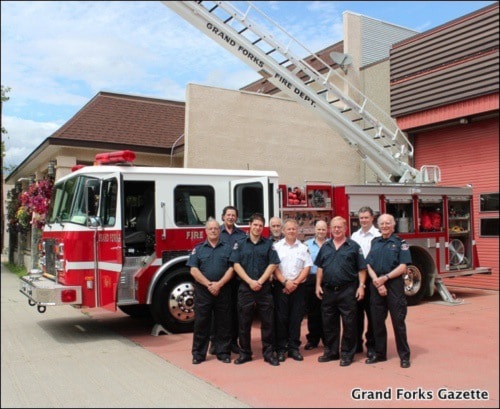Grand Forks Fire Rescue continues the process to purchase a new ladder truck, which will tackle modern firefighting and hopefully lower insurance for residents.
A decision is pending final approval from the city and community – Grand Forks Fire Chief Dale Heriot said the volunteer department has looked at several types of trucks and estimates that it could cost upwards of $1 million.
With the current ladder truck being 20 years old, it no longer meets criteria for Fire Underwriters Survey of Canada insurance standards (the company that assesses the ability of communities to protect themselves from fire and provides information to insurance companies).
Furthermore, firefighting in the Grand Forks area has changed with taller structures and with such developments as Silver Kettle Village, seniors with limited mobility will need extra help being evacuated.
The new fire truck will have to meet requirements not only in the modern day but for the next 20 years as well.
“What we’re looking for this time is a platform ladder truck,” Heriot explained. “Twenty years ago when we bought our original ladder truck, we only fought fire with it and that was it. Now we do high-angle rescue, low-angle rescue, confined space rescue, swift water rescue and many other rescue situations and a platform ladder truck is much easier suited for us – safer for us and way more efficient for rescuing public.”
Grand Forks Fire Rescue also deals with hazardous material response.
Insurance issues
According to information provided by the department, fire underwriters have a national grading system used to establish insurance rates for property owners, which is directly linked to the level of fire risk – better and recognized fire protection lessens the insurance cost.
Two grades are given to communities: Public Fire Protection Classification (PFPC), which measures the ability to fight industrial or commercial fires (a 1 indicates the best protection and a 10 no organized fire protection) and the Dwelling Protection Grade (DPG), which measures the ability to fight a single family residential fire – similar to the PFPC a 1 is considered the best and a 5 indicates no organized fire protection.
The PFPC for Grand Forks is 6 while the DPG is 2 and Heriot said he was quite happy with the ratings.
“Residentially (DPG), we’re graded at a 2; the only way we could get a 1 is if we had a full-time staff, so 2 is really good,” Heriot explained. “That’s part-in-parcel to the commitment of our volunteers and the quality of our apparatuses because we keep them up-to-date and in good shape, otherwise we wouldn’t get a 2.”
In terms of lowering the 6 PFPC grade, the purchase of a new ladder truck and improved fire prevention and improvements to the city water system would help, the fire chief said,
“We could quite likely get the fire underwriters back in and we may have a good shot at getting a 5, which makes a huge difference for fire insurance for commercial and industrial,” opined Heriot, adding that the only way for the department to go below 5 would be to have full-time staff.
Finances
The department gave an example of a home within Grand Forks valued at $300,000 and based on the estimated cost of a ladder truck financed over five years – the yearly tax implication per resident would be around $87.
The average annual insurance cost for the $300,000 home would be $925 with the current insurance grade and if the ladder truck was not replaced, the rate could skyrocket by 32 per cent or $296 a year according to the department.
“As a fire department, we do things partially for the needs of the community, as far as keeping the community safe. The other part is the best value for the dollar for the community and we don’t just buy equipment to buy equipment,” Heriot said. “We buy equipment that’ll be the most efficient for us and keep people safe.”
The plan has been given preliminary support by Grand Forks city council in initial budget discussions earlier this year. More accurate pricing will be developed and the budget will go back to council in the fall for a final decision.
Anyone with questions can call the fire hall at 250-442-3612 or email Heriot at dheriot@grandforks.ca.
The department (on behalf of the rural fire protection district) also recently announced that it will be getting a new fire tender (tanker) vehicle soon as well.
